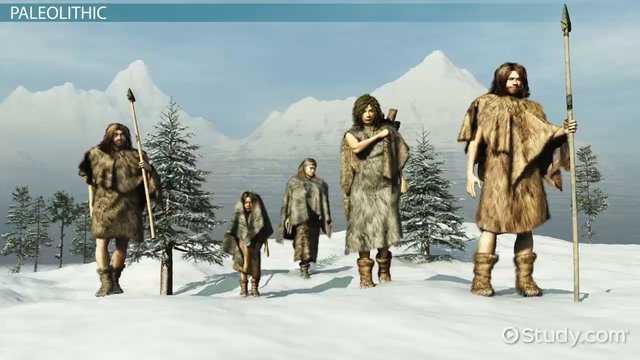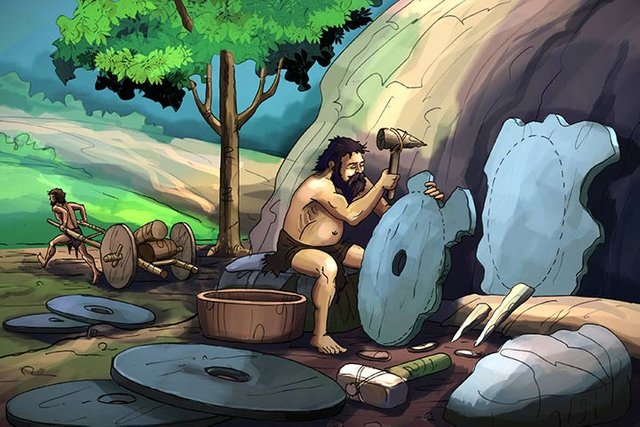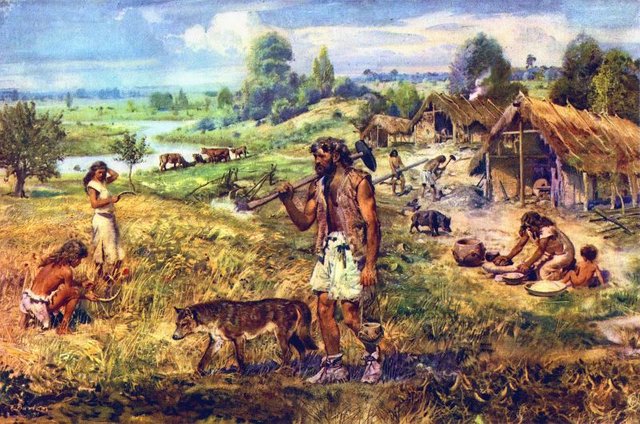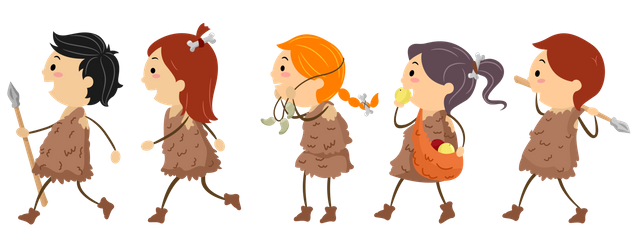The Early Stone Age : Chronology and Adaptation
The Early Stone Age : Chronology and Adaptation

The Palaeolithic period (Old or Earlier Stone Age)

(Greek : Paleos = old and lithos = stone)
(ca million - 10 000 years BP) ( Before Present = BP)
(note that ca is the abbreviation for circa [Latin : about])
During this period, this comprises the Lower, Middle and Upper Palaeolithic, human beings became the creator of culture. Implements developed from being very simple tools to more specialized artefacts. The people of this period were basically hunter-gatherers. Oldowan technology, the handaxe industries of the Acheulian, as well as the other artefacts made by Homo erectus over a period of time that lasted for more than a million years, are generally referred to as the Lower Palaeolithic technology. During the Upper Pleistocene (ca 1.8 mya to 10 000 BP) periods of gradual glaciation and rapid deglaciation caused the cycles of the cold, dry weather experienced during the last inter-glacial and glacial cycle of Ice Age. During full inter-glacial conditions forest and woodlands were found in Europe. The last glacial maximum was reached at about 18 000 BP. Pleistocene literally means "Ice Age".
The Middle Palaeolithic is mostly associated with Mousterian and other stone tool industries. The Mousterian is found in Europe and the Near East (associated with Neandertals and other early Homo Sapiens).
The Upper Palaeolithic (+- 35 000 BP - 10 000 BP) is characterized by various stone industries and technological innovation. Upper Palaeolithic cultures include the Aurignacian (+- 33 000 ya), Gravettian (+- 27000 ya), Solutrean (+- 21 000 ya), and Magdaleenian (+- 17 000 ya). The most significant development of the Upper Palaeolithic was rock art of paintings and engravings - these have been found in different areas over a period of more than 30 000 years. Apart from rock art and sculptures, the art of this era also includes thousands of portable objects of stone, antler, bone, clay, ivory and wood. The global climate of the Upper Palaeolithic was generally harsh (intense cold or arid conditions).
The Mesolithic period (Middle Stone Age)
(ca 10 000 - 8000 years BP)

This is the transitional period falling between the Upper Palaeolithic, when prehistoric humans were still hunter-gathers, and the Neolithic, when humans began to produce food. Major changes in temperature, rainfall and vegetation occurred during the early part of the Holocene. (The Holocene began 10 000 years ago. the Greek word Holos means recent). The Mesolithic toolkit is characterized by composite tools and weapons which were manufactured by hafting (ie firmly attaching) small stone flakes known as microliths to shafts made of wood or bone. In Europe, specialized hunting groups took advantage of the opening up of vast hunting groups took advantage of the opening up of vast hunting grounds on the tundra
and the scrub area which were created by the melting of the glacial ice in the Northern hemisphere. People moved around more extensively than ever before. Some of the prominent cultural groups assimilated other less prominent groups. Indeed, groups which were not integrated with larger groups became extinct. Changing rainfall patterns resulted in the appearance of scrub- and grasslands in the Sahara, as well as shallow lakes - all of which could support an increase in the number of hunter-gatherers.All these changes had dramatic effects on hunter-gatherer societies throughout the world, and these changes, in turn, resulted in behavioral changes, intensification of hunting and gathering, increased social complexity and a gradual shift towards food production. The Mesolithic is characterized by the appearance of efficient and organised communities as a result of increased population growth, territorial expansion, economic stability, technical advancement and invention. Palaeolithic rock art either declined or disappeared altogether in certain regions. During this period, the basis was laid for food - producing economies. The domestication of animals and plant foods was probably introduced independently in various parts of the world in order to supplement the hunting and gathering lifestyle and in order to cope with population growth.
The Neolithic Period (Late Stone Age)
(ca 8000 - 5000 years BP)

This period saw development of agriculture as a means of livelihood. The economic intensification resulted in pround cultural changes. This economic intensification meant that more permanent settlement, as well as more substantial housing, became desirable. Also, specialized implements were needed for the cultivation, harvesting and processing of food resources, surplus crops had to be stored and trade became part of life - all of this obviously meant that social life became considerably more complex.
The development of agriculture meant, obviously, that people began more on cultivated crops and domestic animals for food supplies and less on hunting and gathering. During this period, grinding and polishing are the main techniques used in the manufacture of stone implements.
Most of the abovementioned terms are generally used in African Archaeology, but the significance of these terms does vary between regions. There has never been a time when a uniform pattern of behavior occurred in a world inhabited by the same sub-species of Homo. Throughout the world, physical morphology, technology, behavior and social organisation have all varied extensively since human beings earliest beginnings.
The nearest there has ever been to a universal human culture probably occurred during the period of early hunter-gatherer groups, we say this because of the widespread occurrences of handaxes, which appears to suggest a general, global development.
Adaptation and subsistence patterns for the Oldowan and Acheulian Industrial Complexes

~ Acheulian stone tool technology indicates that Acheulian toolmakers can be regarded as hunter-gathers.
~ However, some reseachers believe that the Oldowan toolmaker were primarily scavengers rather than hunters.
~ It has also been suggested that the meat scavenged from carnivore kills was taken to home bases, where the meat was shared. Such behavior led to improved communication skills and to the development of more complex social relationships. Large concentrations of Acheulian tools consisting mainly of handaxes were, for example, found at Olorgesaille, Kenya, which is interpreted as a Middle Pleistocene butchering site.
~ At most of the opensites, the implements, the implements have been moved and redeposited through erosion and water action. Very few ESA sites in South Africa, therefore have bones and artefacts in primary context. One such site is Elandsfontein "Cutting 10", which is an example of a butchering site with fauna showing signs of human and carnivore scavenging and evidence of human hunting ( as well as natural mortality). Today, Elandsfontein has no nearby supply of fresh water, but seasonal lakes existed during the Upper and Middle Pleistocene.
~ From the few known sites with faunal remains it seems that the Acheulian people hunted and/or scavaged a wide variety of herbivores, it is also assumed that plant foods were exploited to some extent.
~ The wide distribution of Acheulian assemblages indicate a substantial population increase and also suggests that Acheulian hominins could adapt to a very wide variety of environmental conditions. Before, relatively open areas were the preferred environment. However, Acheulian sites occur over a vast area, which suggests that these hominins could cope with arid and wooden regions, Coastal sites were also exploited (eg the dune area at Geelhoutboom near Klasies River Mouth). However, here is no direct evidence that marine resources were utilised.
~ An analysis of settlement patterns has indicated that Acheulian hominins preferred sites near water soucres, especially river valleys. This offers one explanation why so many of their tools are found within the sands and gravels of ancient river systems into which they were washed from the original living sites beside the water. Rich sources of raw material for tool manufacture probably account for the repeated occupation of certain sites. However, it is impossible to determine to what extent and for what length of time these sites were occupied.
~ The considerable energy used to transport preferred stone materials to some sites must indicate that early hominins were capable of deliberate planning. Extensive Acheulian sites occur, for example, in Vaal-Orange drainage basin near rivers, pans and springs. The vast quantities of ESA bifaces at sites such as Kathu Pan, Canteen Kopje, Pniel and numerous others, seems to indicate a substantial presence of human beings.
~ Although Acheulian assemblages usually occur in open places, some instances of cave and rock shelter occupation are known. Wonderwerk Cave in the northern Cape, The Cave of Hearths in Makapan Valley (Potgietersrus/ Mokopane) and Montagu Cave in the Western Cape are some of the rare cave sites that have been used as a home base during the ESA. The deep, dark hominin-bearing caves such as Sterkfontein and Swartkrans were probably not suitable as living sites. The fossils which originate from these caves probably accumulated as a result of the feeding activities of carnivores and scavengers, (and natural occurrences).
~ Preservation of organic materials and fauna other than charcoal is limited to a few sites in South and East Asia. A piece of wood from Amanzi Springs (near Uitenhage) shows possible cut marks on it. Kalambo Falls in Zambia provides evidence of woodworking.
~ In Africa direct evidence for the use of fire has only been found at very late Acheulian sites, probably because acid soils do not preserve charcoal.
~ The earliest direct evidence for the controlled use of fire was found in association with Homo erectus at Swartkrans near Krugersdrop, Gauteng. The most recent excavations of the hominin-bearing breccias (a breccia is a rock containing fragments) in the Swartkrans cave have yielded what appear to be burnt bones from Member 3 (about 1.0 to 1.5 mya) (Brain & Sillen)
~ Some of the Acheulian levels at the Cave of Hearths indicate possible control of fire in South Africa. However, Upper Pleistocene MSA sites show reliable evidence of widespread human control of fire at least 130 000 years ago and probbly much earlier.
~ The use of fire to cook food makes it more tender, detoxifies a number of otherwise poisonous plants and therefore extends the range of plant foods that can be utilised.
It also aids the absorption of high-energy complex carbohydrates such as starch. High-quality foods and the predisgestion of foods through cooking require less energy, which caused a reduction in the size of the digestive tract (termed a "cheap gut") so that humans been able to afford the costs of larger brains (Haviland, Deacon & Deacon) Tools and fire gave the early hominins more control over their environment. Fire provides illumination, warmth and protection. It could also be used as an aid in the manufacture of implements.
Thank you for reading
References: Deacon & Deacon
Haviland
Please Follow me for more on Archaeology and History.
Please check out my other posts related to The Early Stone age:
The Early Stone Age : The Industrial Complexes
The Early Stone Age : Physical types associated with it.
Thank you @foundation for this amazing SteemSTEM gif

Upvoted on behalf of the dropAhead Curation Team!
Your post will be Resteemed by @dropahead witness account of the dropAhead curation team!
Watch out for the #xx-votesplus tag!
By doing the above you will give us more STEEM POWER (SP) to give YOU more earnings next time.
Keep up the good work!
Most recent post: Moving #25_votes_plus to Discord
Another interesting article. Thanks for sharing this!
....upvoted and resteemed
great work @zest. keep it up!
Hi @huitemae, Thank you so much!!! I will catch up with you in SteemSTEM chatroom:)
Nice share.....thanks @zest